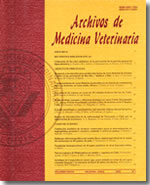Comparison of two diagnostic techniques to bovine viral diarrhea disease (BVD) in 50 dairy herds from the Xth Region, Chile. Seroneutralization test and indirect immunosorbent assay (I-ELISA)
Main Article Content
Abstract
Bovine viral diarrhea/Mucosal disease (BVD/MD) is a highly spread virosis worldwide and has a great impact in bovine reproduction and production. In Chile, the disease has been reported with over 60% of prevalence and it demands adecuate diagnostic methods.
Curently the official serologic diagnostic test in Chile is the serum neutralization test (SNT), this method detects the presence of antibodies against the BVD virus and it is considered to have good specificity and sensitivity, althought, it presents some disadvantages in its interpretation and in its execution.
The aim of this investigation was to compare de SNT as gold standard, with a commercial immunosorbent assay (ELISA), in terms of specificity and sensitivity in the detection of antibodies against BVD antigens. A set of 500 bovine sera drawn from 50 milk herds from the Xth Region of Chile were analized.
The results showed that the SNT detected 278 serum samples as positives and the ELISA detected 347 serum samples as positives, these represents for ELISA test a relative sensitivity and specificity of 91% and 57%, respectively. Statistically significant differences of the serodiagnosis obtained in both tests were established through the McNemar test (<0.05), and a median concordance between them through the Kappa test. When the SNT titers were related with the optical densities (OD) of ELISA, a positive association was detected between this values.
It was concluded that ELISA provides good results in comparison with SNT, having the former a higher number of detections because its dignostic higher sensitivity. Therefore, ELISA is an appropiate diagnostic method for large populations of cattle.

